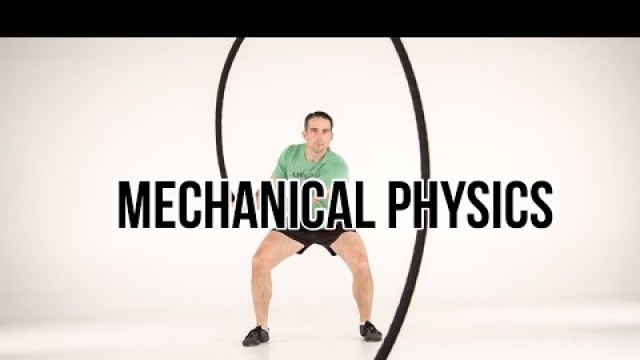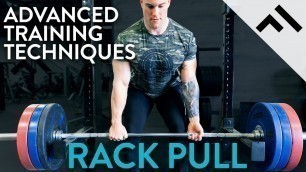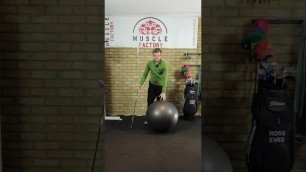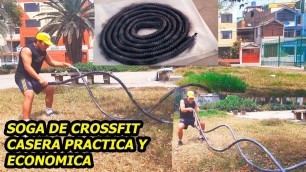

09:53
May 23, 2021
3
4
'This is an excerpt from our Battle Ropes Certification. It discusses how the physics of battle ropes make it such a unique fitness tool! If you are interested in learning the free basics of battle ropes, checkout Level 1 here: https://www.living.fit/offers/mDLL62GV/checkout Mechanical Physics Force is force is force Dr. Andreo Spina has been quoted as saying, “force is the language of cells,” and I would agree that when it comes to adaptation, soft tissue, osseous tissue, muscle tissue, and skin tissue need force in certain directions communicated to the structure over and over again for an adaptation to occur. This is how bones harden or soften. This is how ligaments strengthen or weaken. This is how muscle tissue grows, shrinks, and changes. This is how scars are formed. It is force, not a particular force-producing object that incites adaptation, so as long as a body, rope, dumbbell, kettlebell, sandbag, or other implement can generate the proper force in the proper direction, one can create an adaptation toward power, strength, endurance, stability, and mobility. SAID Principle[1] Specific Adaptations to Imposed Demands is a principle by which all humans function within. If we sit on a couch all day for years. The adaptation will be a reduction of lean body mass, osseous tissue, nervous connection, and limited function of both brain and body. If we train specific movement patterns under heavy loads, our specific adaptations will be toward improving our efficiency and effectiveness of moving in that way with those loads. Our body\'s systems will re-organize and adapt to become stronger and better at those movements. Understanding this principle should immediately lend itself toward the myriad of possible ways one can create increased outputs in the limitless number of ways to move the fluid and dynamic rope. Power Output (measured in watts) FORCE (mass * acceleration) times DISTANCE (Displacement) over TIME equals POWER OUTPUT (for one iteration, not for total volume or duration or multiple sets) [2] Force and Distance have a positive or direct relationship to Power Output, meaning if you increase force (mass or acceleration) or your increase distance, it will increase power output if everything else remains the same. Also, if you decrease force or distance it will decrease power output. Time has an inverse relationship to Power Output, meaning if your increase time it will decrease power output, and if your decrease time it will increase power output. Now that we understand this, let’s make it sink in through demonstrating a basic human movement or exercise that we regularly use, and look at each variable in the equation. Increase in Force equals an increase in Power More Weight (Mass) or faster speeds Increase in Distance equals an increase in Power More distal movements or bigger movements Decrease in Time equals an increase in Power Faster Speeds of the movement Decrease in Force equals a decrease in Power Less Weight (Mass) or slower speeds of movement Decrease in Distance equals decrease in Power More proximal movements or smaller movements Increase in Time equals a decrease in Power Slower speeds of the movement *Think of an exercise. Write it in the comments below, and then write how you would change the force or the distance or the time to adjust the power output up or down. Here are two examples: Rower-In a single row, if I speed up the movement, I simultaneously increase the acceleration, which increases the force, and I decrease the time. Both of these variables increase the Power (which I can see if I look at the Wattage metric on my display. The opposite happens if I slow down the row. I can also adjust the resistance on the fan, which will make the pull easier or more difficult, but it won’t increase the mass or decrease the mass. The other variable I can adjust is the distance, if I can pull it further in the same amount of time, I will increase the watts. If I don’t pull it as far over the same period of time I will decrease the watts or power. Each pull will indicate a new measurement of watts (power output), which makes the erg a great example of the single iteration concept. Making someone do more pulls or less pulls, does not necessarily change the power output (each pull is what dictates the power output). If I make someone do more pulls or less pulls, this increases or decrease the duration of the exercise, and the volume of the exercise. (the same would be represented on a ski erg, cycle, versaclimber, or airdyne/assault bike). Push-up- Please comment below if you have any questions. Fitness plans: https://www.living.fit/all-kettlebell... Subscribe here: https://www.youtube.com/channel/UCYUS... Find us on social media: Instagram: https://www.instagram.com/kettlebellk... Facebook: https://www.facebook.com/kettlebellkings Twitter: https://twitter.com/KB_Kings Websites: (US) https://www.kettlebellkings.com (EU) https://www.kettlebellkings.eu'
Tags: battle ropes , battle rope , battle rope workouts
See also:

















comments